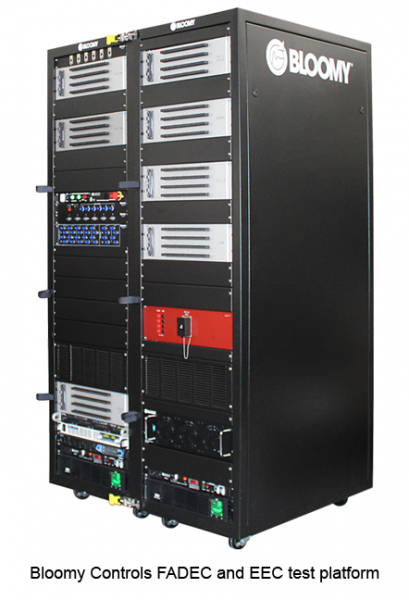Excerpt from 2020 Aerospace Test Special Report
 COTS for HIL
COTS for HIL
Bill Eccles, principal electrical engineer, Alan Murphy, western US Sales manager, and Peter Blume, president, all at Bloomy Controls Inc., said, “Bloomy is the market leader in providing complex, open platform, commercial off-the-shelf (COTS) hardware in-the-loop (HIL) test systems for airborne controls such as electronic engine controls and full-authority digital engine controls (EECs and FADECs), flight control computers, collision-avoidance systems, environmental controls, and mission computer systems. We also provide high-channel-count, high-speed data acquisition and closed-loop controls testing for systems integration labs (SILs) as well as many line replaceable units (LRUs) including electrohydraulic actuators and controls, cockpit controls, and control-surface actuators. In addition, we provide manufacturing automated testing equipment for many of the electronic assemblies that comprise these LRUs. And Bloomy’s MIL-STD-1553B communications solutions have been deployed in over 200 systems worldwide.”
Eccles, Murphy, and Blume said the company offers a range of closed-loop/hardware-in-the-loop (HIL) test platforms that are customer-configured for specific application spaces, including FADECs/EECs, flight-control systems, and environmental controls. “Each platform contains a basic complement of simulation types which may be customized for the customer’s control system requirements,” they said. “The Bloomy Simulation Reference System provides a launching point for other closed-loop/HIL applications. Customers’ test engineers may use these platforms and systems to jump start their test development cycles, thereby shortening schedules, reducing costs, and freeing resources to focus on the differentiating technologies which make their products unique in the marketplace.”
They continued, “Bloomy provides several industry-first modules and interconnection solutions for the National Instruments (NI) Switch, Load, and Signal Conditioning (SLSC) and compactRIO platforms, which our customers can use to speed test-system development using COTS components. These include an 8-channel high-precision thermocouple simulation module, an 8-channel VDT/resolver simulation module, an 8-channel load module, a ThroughPoint interface panel, and a MIL-STD-1553B avionics bus communications module.”
MIL vs. commercial
"The requirements of military and commercial aerospace customers are very similar, with the overriding trend toward increasing the use of commercial, off-the-shelf (COTS) testing equipment in order to reduce cost and lead times," said Eccles, Murphy, and Blume at Bloomy Controls.
Eccles, Murphy, and Blume also cited a divergence between military and commercial customers. “One obvious difference is security; however, most of our aerospace customers have commercial as well as military contracts, and therefore Bloomy is ITAR-registered and has many security procedures in place. Also, military-aerospace applications are increasingly using FAA certification processes where previously they did not—even for mission-related systems. There is also a greater variety of military airborne systems than commercial systems in service, and military systems tend to be reconfigured for different mission profiles, with new sensor hardware, weapons systems, and software requiring integration. Thus, a military aerospace platform tends to have a greater requirement for test/validation throughout its lifecycle.”
Aerospace test trends
Eccles, Murphy, and Blume commented, “The SIL is becoming exponentially more important to Bloomy’s aerospace customers as the complexity of their control systems increases. We expect that the wide variety of sub-tier suppliers of controls and their test systems will require commonality and interoperability of these test systems. It is likely that the coming months and years will, by necessity, see standards emerge for standardizing the command and control of these test systems as well as for sharing data among them.”
Source
Nelson, Rick – Aerospace Test Special Report, EE-Evaluation Engineering, February 2020.
Related Links

